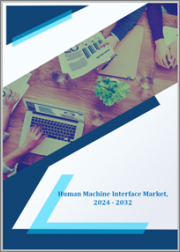
|
시장보고서
상품코드
1616804
세계의 터치식 휴먼 머신 인터페이스(HMI) 시장 규모 : 구성요소별, 기술별, 용도별, 지역별, 범위 및 예측Global Touch Based Human Machine Interface (HMI) Market Size By Component, By Technology, By Application, By Geographic Scope And Forecast |
||||||
터치식 휴먼 머신 인터페이스(HMI) 시장 규모와 전망
터치식 휴먼 머신 인터페이스(HMI) 시장 규모는 2023년 367억 8,000만 달러로 평가되며, 2024-2030년 예측 기간 동안 24.24%의 CAGR로 성장하여 2030년까지 2,550억 달러에 달할 것으로 예상됩니다.
터치식 휴먼 머신 인터페이스(HMI) 세계 시장 촉진요인
터치식 휴먼 머신 인터페이스(HMI) 시장의 시장 촉진요인은 다양한 요인에 의해 영향을 받을 수 있습니다.
산업 자동화의 부상:
산업 자동화의 부상: 제조업, 자동차, 의료 등 많은 산업에서 산업 자동화가 진행됨에 따라 인간과 기계 사이의 사용자 친화적이고 효과적인 인터페이스에 대한 필요성이 증가하고 있습니다.
터치스크린 기술의 지속적인 발전:
정전식 터치스크린, 제스처 인식, 멀티 터치 인터페이스 등 터치 기반 HMI는 사용자 경험을 향상시키고 애플리케이션의 폭을 넓히고 있습니다.
사용자 친화적인 인터페이스에 대한 수요:
소비자들이 스마트폰이나 태블릿과 같은 일반 기기에서 볼 수 있는 직관적인 터치 인터페이스에 익숙해지면서 터치 기반 HMI의 인기가 높아지고 있습니다. 이는 고객이 상업용 및 산업용 장비에서도 유사한 인터페이스를 기대하기 때문입니다.
효율성 및 비용 효율성:
터치 기반 HMI는 복잡한 제어판이나 기존의 기계식 인터페이스에 비해 가격이 저렴한 경우가 많습니다. 절차가 간소화되고, 인적 오류의 가능성이 낮으며, 업무 효율성이 향상되기 때문에 조직에 매력적입니다.
인더스트리 4.0 및 사물인터넷(IoT)과의 통합:
실시간 모니터링, 원격 제어, 예지보전, 데이터 분석을 제공하는 IoT 기술과 인더스트리 4.0 프로젝트의 통합은 링크 시스템 및 스마트 팩토리에서 터치 기반 HMI의 사용을 촉진할 것입니다.
스마트 기기의 수요 확대:
스마트 기기와 웨어러블 기술이 확산되면서 업무용 기기 및 산업용 기기의 터치 인터페이스에 대한 수요가 증가하고 있습니다.
인체공학 및 안전성 향상:
터치 기반 HMI는 마모되거나 오작동하기 쉬운 물리적 버튼과 스위치를 제거함으로써 인체공학 및 안전성을 향상시킬 수 있습니다. 또한, 보다 인체공학적인 설계가 가능해져 작업자의 작업 환경을 개선할 수 있습니다.
규제 준수 및 표준화:
터치 기반 HMI의 채택은 사용자 인터페이스 디자인, 안전, 접근성 등에 관한 업계 표준 및 규정 준수에 의해 촉진되고 있습니다.
리모트 액세스 및 제어에 대한 수요:
특히 COVID-19와 같은 세계적인 전염병으로 인해 산업 장비에 대한 원격 액세스 및 제어에 대한 요구가 증가함에 따라 원격 모니터링 및 조작을 용이하게 하는 터치 기반 HMI의 인기가 높아지고 있습니다.
사용자 정의 및 유연성:
터치 기반 HMI는 기존 인터페이스에 비해 커스터마이징 옵션과 유연성이 뛰어나 사용자 고유의 요구와 취향에 맞게 인터페이스의 기능, 레이아웃 및 피드백 메커니즘을 조정할 수 있습니다.
터치식 휴먼 머신 인터페이스(HMI) 세계 시장 억제요인
터치식 휴먼 머신 인터페이스(HMI) 시장에는 몇 가지 요인이 억제요인으로 작용할 수 있습니다. 다음과 같은 요인이 있습니다.
초기 투자 비용:
높은 초기 투자 비용: 예산이 한정된 중소기업은 터치 기반 HMI 시스템 도입에 따른 초기 비용(하드웨어, 소프트웨어, 설치, 교육 등)을 마련하기 어려울 수 있습니다. 특히 수익성이 낮은 분야에서는 도입에 걸림돌이 될 수 있습니다.
보안 문제:
보안 문제사물인터넷(Internet of Things) 및 다른 링크 시스템과 상호연결된 터치 기반 HMI는 악성코드 공격, 해킹, 데이터 유출의 영향을 받기 쉽습니다. 특히 중요한 인프라 분야에서는 기밀 데이터 및 업무 시스템에 대한 보안 우려로 인해 터치 기반 HMI 기술 채택을 꺼리는 기업도 있을 것으로 보입니다.
호환성 문제:
터치식 HMI 시스템을 도입하거나 통합할 때, 기존 레거시 하드웨어 및 소프트웨어 플랫폼과의 호환성에 문제가 발생할 수 있습니다. 호환성을 보장하기 위해 구형 시스템을 업그레이드하거나 교체하려면 더 많은 시간, 비용 및 리소스가 필요할 수 있습니다.
구현 복잡성:
터치 기반 HMI 시스템 도입은 특히 대규모 산업 환경에서는 많은 도전과제와 혼란을 야기할 수 있습니다. 직원 재교육, 워크플로우 재검토, 기존 장비 변경, 변화에 대한 저항 극복 등이 필요하며, 이 모든 것이 수용 및 도입 일정을 지연시킬 수 있습니다.
신뢰성과 견고성에 대한 우려:
산업용 터치스크린은 먼지, 진동, 온도 변화, 습도, 화학제품 노출 등 가혹한 사용 환경을 견뎌내야 합니다. 이러한 상황에서 터치 HMI 시스템의 신뢰성, 견고성 및 수명에 대한 우려는 구매 선택과 채택률을 좌우할 수 있습니다.
표준화 부족:
터치식 HMI 시스템에는 공통된 표준이나 프로토콜이 없기 때문에 벤더 간 상호 운용성에 문제가 발생하여 외부 하드웨어 및 소프트웨어 구성요소와의 원활한 통합을 방해할 수 있습니다. 이러한 표준화의 부재는 최종사용자의 선택과 유연성, 확장성을 제한할 수 있습니다.
사용자 수용 및 교육:
기존 제어 인터페이스에서 터치 기반 HMI로 전환할 때 운영자 및 유지보수 담당자가 새로운 기술과 인터페이스 패러다임을 이해하기 위해서는 상세한 교육을 제공해야 할 수도 있습니다. 새로운 인터페이스의 도입에 따른 변화에 대한 저항과 학습 곡선은 새로운 인터페이스가 널리 수용되고 활용되는 것을 방해할 수 있습니다.
규제 준수 과제:
터치 기반 HMI 시스템은 의료기기, 항공우주, 자동차 산업과 같은 안전이 중요한 애플리케이션에 사용되는 경우, 조작성, 신뢰성, 안전성에 대한 엄격한 규정과 표준을 준수해야 합니다. 터치 기반 HMI 시스템의 개발 및 구현은 이러한 법규를 준수하기 위해 더 많은 비용이 소요됩니다.
목차
제1장 소개
- 시장 정의
- 시장 세분화
- 조사 방법
제2장 주요 요약
- 주요 조사 결과
- 시장 개요
- 시장 하이라이트
제3장 시장 개요
- 시장 규모와 성장의 가능성
- 시장 동향
- 시장 성장 촉진요인
- 시장 성장 억제요인
- 시장 기회
- Porter's Five Forces 분석
제4장 터치식 휴먼 머신 인터페이스(HMI) 시장 : 구성요소별
- 터치 스크린
- 터치 패드
- 터치 센서
제5장 터치식 휴먼 머신 인터페이스(HMI) 시장 : 기술별
- 정전용량식
- 저항막 방식
- 표면 탄성파(SAW)
- 적외선
- 광학 이미징
제6장 터치식 휴먼 머신 인터페이스(HMI) 시장 : 용도별
- 산업 자동화
- 헬스케어
- 자동차
- 소매
- 가전
제7장 지역 분석
- 북미
- 미국
- 캐나다
- 멕시코
- 유럽
- 영국
- 독일
- 프랑스
- 이탈리아
- 아시아태평양
- 중국
- 일본
- 인도
- 호주
- 라틴아메리카
- 브라질
- 아르헨티나
- 칠레
- 중동 및 아프리카
- 남아프리카공화국
- 사우디아라비아
- 아랍에미리트
제8장 시장 역학
- 시장 성장 촉진요인
- 시장 성장 억제요인
- 시장 기회
- COVID-19의 시장에 대한 영향
제9장 경쟁 구도
- 주요 기업
- 시장 점유율 분석
제10장 기업 개요
- Siemens AG
- Schneider Electric SE
- General Electric
- ABB Ltd
- Fuji Electronics Co Ltd
- Mitsubishi Electric Corporation
- Omron Corporation
- Advantech Corporation
제11장 시장 전망과 기회
- 신기술
- 향후 시장 동향
- 투자 기회
제12장 부록
- 약어 리스트
- 정보 출처와 참고문헌
Touch Based Human Machine Interface (HMI) Market Size And Forecast
Touch Based Human Machine Interface (HMI) Market size was valued at USD 36.78 Billion in 2023 and is projected to reach USD 255 Billion By 2030 , growing at a CAGR of 24.24% during the forecast period 2024 to 2030. Global Touch Based Human Machine Interface (HMI) Market Drivers The market drivers for the Touch Based Human Machine Interface (HMI) Market can be influenced by various factors. These may include:
Rise in Industrial Automation:
As industrial automation rises in a number of industries, including manufacturing, automotive, healthcare, and others, there is an increasing need for user-friendly and effective interfaces between humans and machines.
Continued developments in touchscreen technology:
Including as capacitive touchscreens, gesture recognition, and multi-touch interfaces, are improving user experience and broadening the range of applications for touch-based HMIs.
Demand for User-Friendly Interfaces:
Touch-based HMIs are becoming more and more popular as consumers grow acclimated to the intuitive touch interfaces seen in commonplace devices like smartphones and tablets. This is because customers are expecting similar interfaces in commercial and industrial equipment.
Efficiency and Cost-Effectiveness:
When compared to intricate control panels or conventional mechanical interfaces, touch-based HMIs frequently provide more affordable options. They are appealing to organizations because they simplify procedures, lower the possibility of human error, and boost operational effectiveness.
Integration with Industry 4.0 and Internet of Things (IoT):
Touch-based HMI usage in linked systems and smart factories is facilitated by the integration of IoT technologies and Industry 4.0 projects, which provide real-time monitoring, remote control, predictive maintenance, and data analytics.
Growing Demand for Smart Devices:
As smart devices and wearable technology proliferate, there is a growing demand for touch interfaces in commercial and industrial equipment because of the increased familiarity and acceptability of these interfaces.
Improved Ergonomics and Safety:
By eliminating the need for physical buttons and switches, which are prone to wear and malfunction, touch-based HMIs improve ergonomics and safety. Additionally, they make it possible for more ergonomic designs, which improves the working environment for operators.
Regulatory Compliance and Standards:
Touch-based HMI adoption is being driven by adherence to industry standards and regulations, including those pertaining to user interface design, safety, and accessibility.
Demand for Remote Access and Control:
Touch-based HMIs that facilitate remote monitoring and operation are becoming more and more popular as a result of the demand for remote access and control of industrial equipment, particularly in the wake of worldwide occurrences like the COVID-19 epidemic.
Customization and Flexibility:
Compared to traditional interfaces, touch-based HMIs provide users with more customization options and flexibility, enabling them to adapt the interface's functionality, layout, and feedback mechanisms to suit their unique needs and preferences.
Global Touch Based Human Machine Interface (HMI) Market Restraints
Several factors can act as restraints or challenges for the Touch Based Human Machine Interface (HMI) Market. These may include:
High Initial Investment:
Small and medium-sized businesses (SMEs) with tight budgets may find it difficult to afford the initial costs associated with deploying touch-based HMI systems, which include hardware, software, installation, and training. Adoption may be hampered by this, especially in sectors with narrow profit margins.
Security Issues:
Touch-based HMIs that are interconnected with the Internet of Things and other linked systems are susceptible to malware assaults, hacking, and data leaks. Certain firms may be discouraged from adopting touch-based HMI technology due to security concerns over sensitive data and operational systems, particularly in critical infrastructure sectors.
Compatibility Problems:
During deployment and integration, compatibility problems between touch-based HMI systems and current legacy hardware or software platforms may provide difficulties. To ensure compatibility, upgrading or replacing outdated systems could take more time, money, and resources.
Complexity of Implementation:
Touch-based HMI system implementation can be challenging and disruptive, especially in large-scale industrial settings. It could entail retraining staff, revamping workflows, modifying current equipment, and overcoming resistance to change, all of which could cause acceptance and implementation timelines to drag out.
Dependability and Sturdiness Concerns:
Industrial touchscreens have to survive challenging operating circumstances such dust, vibration, temperature changes, humidity, and chemical exposure. In such circumstances, apprehensions regarding the dependability, robustness, and lifespan of touch-based HMI systems could sway buying choices and adoption rates.
Lack of Standardization:
The lack of common standards and protocols for touch-based HMI systems can cause problems with vendor-to-vendor interoperability and impede smooth integration with external hardware and software components. For end users, this lack of standardization could restrict their options, flexibility, and scalability.
User Acceptance and Training:
To acquaint operators and maintenance staff with the new technology and interface paradigms, it may be necessary to provide them with in-depth training when switching from traditional control interfaces to touch-based HMIs. Widespread acceptance and utilization might be hampered by resistance to change and the learning curve involved in implementing new interfaces.
Challenges with Regulatory Compliance:
Touch-based HMI systems must adhere to strict regulations and standards for usability, reliability, and safety when utilized in safety-critical applications including medical devices, aerospace, and automotive industries. The development and implementation of touch-based HMI systems become more sophisticated and expensive in order to ensure compliance with these laws.
Global Touch Based Human Machine Interface (HMI) Market Segmentation Analysis
Global Touch Based Human Machine Interface (HMI) Market is segmented based on Component,
Technology,
Application, and Geography.
Touch Based Human Machine Interface (HMI) Market, By Component
- Touch Screens:
- Touch-sensitive displays that allow users to interact directly with the screen by touching it, commonly used in smartphones, tablets, and industrial control systems.
- Touch Pads:
- Small touch-sensitive surfaces typically found on laptops, keyboards, and electronic devices, enabling cursor movement or gesture-based input.
- Touch Sensors:
- Devices that detect touch or proximity, converting physical touch into electrical signals, crucial components in touchscreens and interactive surfaces.
Touch Based Human Machine Interface (HMI) Market, By Technology
- Capacitive:
- Utilizes the body's capacitance to detect touch, known for its high sensitivity and responsiveness, commonly used in smartphones and tablets.
- Resistive:
- Comprises multiple layers that respond to pressure, offering durability and compatibility with stylus input, often found in industrial control panels and POS systems.
- Surface Acoustic Wave (SAW):
- Relies on ultrasonic waves to detect touch, providing high clarity and durability, suitable for public kiosks and gaming machines.
- Infrared:
- Uses infrared light beams to detect touch or proximity, offering robustness and operation in harsh environments, frequently employed in interactive whiteboards and digital signage.
- Optical Imaging:
- Utilizes cameras or sensors to capture touch interactions optically, offering multi-touch capabilities and flexibility, commonly used in large interactive displays and smart tables.
Touch Based Human Machine Interface (HMI) Market, By Application
- Industrial Automation:
- Touch-based interfaces used in control panels and HMI systems to monitor and manage manufacturing processes efficiently.
- Healthcare:
- Touch-enabled devices and interfaces used for medical equipment control, patient monitoring, and electronic health record systems.
- Automotive:
- Touchscreens and touch-sensitive controls integrated into vehicle dashboards for navigation, entertainment, and climate control systems.
- Retail:
- Touch-based POS terminals, interactive displays, and kiosks facilitating customer engagement, payment processing, and product information delivery.
- Consumer Electronics:
- Touchscreens and touch-sensitive interfaces prevalent in smartphones, tablets, smartwatches, and home appliances for intuitive user interaction and control.
Touch Based Human Machine Interface (HMI) Market, By Geography
- North America:
- Market conditions and demand in the United States, Canada, and Mexico.
- Europe:
- Analysis of the Touch Based Human Machine Interface (HMI) Market in European countries.
- Asia-Pacific:
- Focusing on countries like China, India, Japan, South Korea, and others.
- Middle East and Africa:
- Examining market dynamics in the Middle East and African regions.
- Latin America:
- Covering market trends and developments in countries across Latin America.
Key Players
- The major players in the Touch Based Human Machine Interface (HMI) Market are:
- Siemens AG
- Schneider Electric SE
- General Electric
- ABB Ltd
- Fuji Electronics Co Ltd
- Mitsubishi Electric Corporation
- Omron Corporation
- Advantech Corporation
TABLE OF CONTENTS
1. Introduction
- Market Definition
- Market Segmentation
- Research Methodology
2. Executive Summary
- Key Findings
- Market Overview
- Market Highlights
3. Market Overview
- Market Size and Growth Potential
- Market Trends
- Market Drivers
- Market Restraints
- Market Opportunities
- Porter's Five Forces Analysis
4. Touch Based Human Machine Interface (HMI) Market, By Component
- Touch Screens
- Touch Pads
- Touch Sensors
5. Touch Based Human Machine Interface (HMI) Market, By Technology
- Capacitive
- Resistive
- Surface Acoustic Wave (SAW)
- Infrared
- Optical Imaging
6. Touch Based Human Machine Interface (HMI) Market, By Application
- Industrial Automation
- Healthcare
- Automotive
- Retail
- Consumer Electronics
7. Regional Analysis
- North America
- United States
- Canada
- Mexico
- Europe
- United Kingdom
- Germany
- France
- Italy
- Asia-Pacific
- China
- Japan
- India
- Australia
- Latin America
- Brazil
- Argentina
- Chile
- Middle East and Africa
- South Africa
- Saudi Arabia
- UAE
8. Market Dynamics
- Market Drivers
- Market Restraints
- Market Opportunities
- Impact of COVID-19 on the Market
9. Competitive Landscape
- Key Players
- Market Share Analysis
10. Company Profiles
- Siemens AG
- Schneider Electric SE
- General Electric
- ABB Ltd
- Fuji Electronics Co Ltd
- Mitsubishi Electric Corporation
- Omron Corporation
- Advantech Corporation
11. Market Outlook and Opportunities
- Emerging Technologies
- Future Market Trends
- Investment Opportunities
12. Appendix
- List of Abbreviations
- Sources and References



















